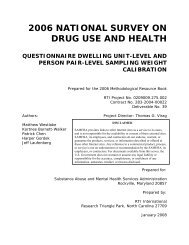1 ATTACHMENT I: STATEMENT OF WORK Section C : Description ...
1 ATTACHMENT I: STATEMENT OF WORK Section C : Description ...
1 ATTACHMENT I: STATEMENT OF WORK Section C : Description ...
Create successful ePaper yourself
Turn your PDF publications into a flip-book with our unique Google optimized e-Paper software.
the same categories of payment source and service type as the estimates that are already<br />
developed for overall national health expenditures and the previous sets of MH/SA<br />
expenditure estimates disseminated by SAMHSA. It will also provide for separate<br />
estimates for mental health and substance abuse treatment services, and for estimates by<br />
payers and provider types. The estimates developed will be made comparable to the<br />
estimates.<br />
The approach taken to estimate national MH/SA spending was designed to be consistent<br />
with the National Health Accounts (NHA). The NHA constitutes the framework for<br />
which the estimates of spending for all health care are constructed by CMS. The<br />
framework can be considered as a two-dimensional matrix; along one dimension are<br />
health care providers or products that constitute the U.S. health care industry; along the<br />
other dimension are sources of funds used to purchase this health care.<br />
The Centers for Medicare and Medicaid Services has a long history, as well as substantial<br />
expertise, in estimating national spending. The estimates of MH/SA spending for non-<br />
MH/SA specialty facilities were carved out of estimates of total national health services<br />
and supplies expenditures developed by CMS. Separate estimates were developed from<br />
SAMHSA data for specialty MH/SA facilities. Duplicate expenditures between the two<br />
sectors were removed. Then, sector estimates were summed to obtain total national<br />
spending for mental health (MH), alcohol abuse (AA), illicit drug abuse (DA) and for<br />
total MH/SA in the U.S. from 1991 through 2001. Finally, MH/SA dollars were<br />
compared to all personal health care and government public health expenditures, which<br />
are referred to as national health care expenditures or all health expenditures. Table 1.1<br />
summarizes the methods for estimating MH/SA expenditures for the MH/SA specialty<br />
facilities and other providers.<br />
The public sector payer categories are: Medicare, Medicaid, State and local government<br />
sources other than Medicaid, and Federal sources other than Medicare and Medicaid<br />
(e.g., Veterans Affairs, Department of Defense, and Federal Block Grants). Medicaid<br />
expenditures represent combined Federal and State and local funds under the program.<br />
The private sources are: private insurance, out-of-pocket expenditures, and other private<br />
sources (e.g., philanthropy).<br />
The provider categories are: specialty hospitals, general hospital specialty units, nonspecialty<br />
care in general hospitals, psychiatrists, non-psychiatrist physicians, other nonphysician<br />
professionals, multi-service mental health organizations, free-standing nursing<br />
homes, specialty substance abuse centers, home health, and retail prescription drugs.<br />
Although the definition has differed across SAMHSA surveys and across time, multiservice<br />
mental health organizations generally include any facility that provides a variety<br />
of MH services and that is not hospital-based. Similarly, specialty substance abuse<br />
centers are generally clinics and residential treatment centers that specialize in chemical<br />
dependency.<br />
Expenditures by provider and payer were further divided into inpatient, outpatient, and<br />
residential care. In some cases, providers offered all three types of care. For example,<br />
hospital expenditures could comprise inpatient, outpatient, or residential services.<br />
Pharmaceutical (which includes retail pharmacy only) and home health expenditures<br />
3
















